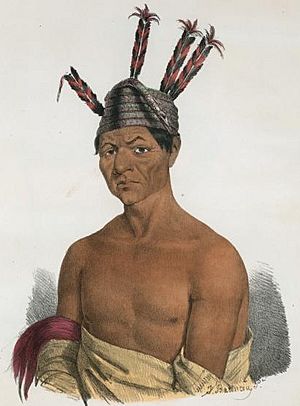Waukon Decorah facts for kids

Waukon Decorah (around 1780–1868) was an important Ho-Chunk (also known as Winnebago) warrior and speaker. He played a key role during the Winnebago War in 1827 and the Black Hawk War in 1832. Even though he wasn't born a chief, he became a strong leader in dealing with the United States government.
Waukon Decorah's Family and Early Life
Waukon Decorah came from a well-known Ho-Chunk family. They lived in what is now Wisconsin, USA. His father was Buzzard Decorah. Buzzard Decorah's mother was a Ho-Chunk chieftess named Glory of the Morning. Her father was a French trader.
Waukon Decorah had a brother named Big Canoe. He was also known as One-Eyed Decorah (around 1772–1864). Sometimes, old stories mixed up these brothers. They were also confused with their uncle, Spoon Decorah. Their cousin, Old Decorah, and his sons were also sometimes mistaken for them.
Some people thought Waukon Decorah was also called "Washington Decorah." This was because he visited Washington, D.C., in the 1820s. However, a US official named Joseph M. Street wrote a letter in 1832. He said he met Waukon Decorah, One-Eyed Decorah, and Washington Decorah. This suggests they were different people. It is still unclear who "Washington Decorah" really was.
Waukon Decorah and the Black Hawk War
In 1829, Waukon Decorah's daughter was killed in Iowa. She had married a Dakota man. Her death was caused by Sauk and Meskwaki raiders. This was part of ongoing fights between the Dakota and the Sauk and Meskwaki tribes. Decorah wanted to get revenge for his daughter. But US officials asked him not to. They were trying to make peace between the tribes.
When the Black Hawk War started in 1832, Decorah was eager to help the Americans. He wanted to fight against Black Hawk's group of Sauk and Meskwaki. He hoped this would finally avenge his daughter's death. Some Ho-Chunks supported Black Hawk. They wanted to stop American expansion. But Decorah gathered warriors from his followers near the Wisconsin River. His brother, One-Eyed Decorah, and his followers from Prairie la Crosse joined him.
After the war, in 1834, Decorah's family faced a tragic attack. He believed this attack was revenge for his help in the Black Hawk War.
Later Life and His Legacy
In 1837, Decorah was part of a Ho-Chunk group. They went to Washington, D.C. They wanted to discuss American settlers moving onto their land. The Ho-Chunk had been allies with the US during the Black Hawk War. But they were pressured to sign a treaty. This treaty gave all Ho-Chunk land west of the Mississippi River to the United States. Decorah signed this treaty as "Wa-kaun-ha-kah (Snake Skin)."
The Ho-Chunk delegates thought they had eight years to leave Wisconsin. They hoped this would give them time to make a new agreement. But the document said they had eight months to move. They had to go to reservations in Iowa and Minnesota. Many Ho-Chunks refused to leave. General Henry Atkinson rounded them up. He escorted them west. However, many later returned to Wisconsin.
Decorah's family moved across the Mississippi River. They settled in a place called "Neutral Ground" in northeast Iowa. Later, he moved to Long Prairie, Minnesota. By 1855, he was living in Blue Earth County, Minnesota. Some older stories say Decorah died in Minnesota. But he seems to have returned to Wisconsin in his final years. In 1868, a newspaper in Mauston, Wisconsin, reported his death. He died on July 18 while living near the Lemonweir River in Mauston.
Two cities in Iowa are often said to be named after him. These are Decorah and Waukon. Waukon is also sometimes said to be named after his son, Chief John Waukon. Other places, like Dekorra, Wisconsin, and Decoria Township, Blue Earth County, Minnesota, are named for his relatives.
In 1859, people in Decorah, Iowa, moved some remains. They believed these were the remains of "Chief Decorah." They did this to make way for the city's growth. The body was re-buried at the county courthouse. However, Waukon Decorah was still alive in 1859. It is not clear whose remains were actually buried there. The remains of the unknown Native American were moved again in 1876. This happened during courthouse renovations.
Waukon Decorah's son, John Waukon, is buried in Oakland Cemetery in Waukon. A new headstone was placed on his grave in November 2007.

